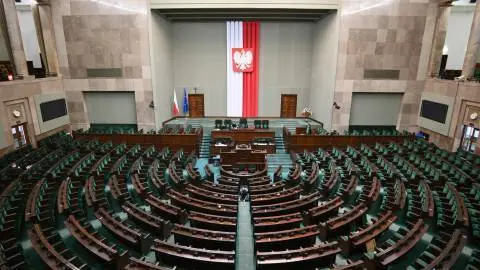Poland’s election result turns EU funding risk on its head
This week’s Polish elections have reduced the risk of a sudden halt to the inflow of EU cohesion funds from next year. We think that potential threat will be reversed if the new government shows a firm commitment to the rule of law, thus enabling the EC to unlock the payments
Sunday's Polish election outcome - where the ruling PiS party won the most votes but an opposition coalition has a significant parliamentary majority - has significantly shifted sentiment, not least regarding relations with the European Union.
We've written extensively before about the risk of a sudden drop in EU fund inflows to the country from 2024 and the impact that might have on sovereign risks within the CEE region. Following the T+3 rule in 2023, Poland has continued to disburse EU funds from the ‘old’ EU budget (2014-20 financial perspective). But because of the deadlock on rule-of-law regulations, the country has not been assured of a smooth and continued flow of money from the ‘new’ EU budget (Recovery and Resilience Fund, RRF, and 2021-27 cohesion funds, CF).
Payments from EU “old” cohesion funds are to end this year
As of the end of August 2023, Poland got €5.9bn from the EU’s cohesion and structural funds, of which €5.2bn is from the ‘old’ budget and €0.7bn comes from the ‘new’ budget (MOF data). The latter constituted some advance payments for project preparations and technical assistance rather than proper project funding.
However, given that Poland disbursed 87% from the “old” budget envelope but contracted its full amount, we estimate that the remaining funds of almost €10bn are to reach final beneficiaries through to the end of the year, with some final settlements in early 2024. The payment pattern of 2022 suggests that major payments are to be made in November and December.
Monthly inflows of EU’s cohesion policy funds to Poland in 2022-23
€ billion

Imminent end of rule-of-law dispute will unlock payments
The winning coalition of three parties strongly committed to restoring the 'rule-of-law' in Poland in their election programmes. They should be able to prove they mean it in the early days of any new government, although forming one may take a couple of months. We assume that based on such an official commitment, agreed upon with the European Commission and other decisions on the judiciary by the new administration, the EC will be able to declare that Poland meets so-called super (or horizontal) milestones from the RRF. This will unlock payments from the RRF.
What's more, because the judiciary provisions are also relevant for the disbursement of cohesion funds (required compliance with the EU Charter of Fundamental Rights, which includes independence of the judiciary), this will also pave the way for more disbursements from the “new” EU budget.
RRF payments not only to fill the CF gap but even add to the upside
However, as far as the cohesion policy funds are concerned, we do not expect immediate large inflows, given that 2024 is a transition year in disbursements from two consecutive financial perspectives from the EU(old 2013-2020 and new 2021-27). Because of Brexit, which reduced the EU’s resources, and thanks to fast-rising real incomes in Poland, the CF to Poland from the new EU budget is more modest than the old one. In the previous transition year, 2016, we experienced a decrease in cohesion and structural funds by more than one half. This time, bureaucracies in Warsaw and Poland were focused on the operationalisation of the RRF and burdened by a long-lasting dispute on the judiciary. This does not bode well for a solid pipeline of fast-disbursing CF projects already in 2024.
Nevertheless, we believe that an upside scenario for EU funds may materialise to some extent with disbursements of the RRF grants of €25billion (an equivalent of 4.4% of GDP), which are to be paid out through to the end of 2026. We estimate that these could fill the gap created by the slowdown in inflows of cohesion funds. With CF and RRF grants, the total gross transfers would reach the previous year’s levels of about 2% of GDP.
As for the economic effects, this will not give an extra boost to GDP growth but rather prevent an expected drag on GDP if RRF money were not there.
Disbursing three semi-annual tranches of RRF grants in 2024 sounds plausible
We assume that in 2024 Poland could receive three RRF grant tranches of about €8bn in total, as outlined in the operational arrangements between the EC and Poland, signed in December 2022. This would require that payments envisaged in tranches #2 and #3 are aggregated into a single tranche and requested for payment next spring and then disbursed after 3 to 4 months in late summer, following a procedure applied in other EU countries.
Annual flows of EU funds to Poland in 2015-25
% of GDP

On the one hand, this is a realistic assumption given that the operational arrangements envisaged six instalments of about €15bn in total to be requested for payment by Q4 2024 (and possibly five instalments of about €12.5bn to be disbursed). On the other, the new government may opt for a revision or update of the National Recovery Plan (NRP) in order to better adjust to its priorities.
This seems a huge and time-consuming task, given that Poland’s current NRP consists of 177 milestones and targets for investments and 106 for policy reforms. But, if there's a will, there's a way, especially if both sides can agree on policy dialogue. One semi-annual instalment of Poland’s NRP amounts to the equivalent of around 0.3% of GDP.
On top of RRF grants, Poland could tap €12+ billion in preferential loans
In addition to grants, Poland may tap EU money from preferential RRF loans; the total envelope is even bigger (€35bn, equivalent to 6% of GDP). While disbursements of these loans could improve Poland’s cash balance with the EU, the returnable funds are rather an alternative to proceeds from the issuance of Poland’s international bonds. Therefore, we do not add them to EU transfers to Poland.
Initially, Poland requested €12 billion of loan allocation, but in the summer of this year, the outgoing government officially scaled this component up to €35 billion.
Initial timeline for payment requests from Poland’s RRF grants and loans, 2022-26

The mentioned EC-Poland operational arrangement envisaged disbursements of 34% of the allocated loans in the three instalments and 55% in five tranches, possibly to be disbursed by Q4 2024. If recalculated to the tripled loan allocation, Poland could tap €12-20billion from RRF loans in 2024. In the draft 2024 state budget, the government assumed €6.5billion funding from this source in the foreign financing of the record-high state budget borrowing needs.
So, the October 15th elections turned the risk of EU fund scarcity in 2024 into the possibility of EU fund abundance. The effective absorption of EU grants and reasonable access to EU loans could provide a solid financing base for policy reforms and investments of the new government.
So, is anyone really still surprised by the recent rally on the Polish assets early this week?
This publication has been prepared by ING solely for information purposes irrespective of a particular user's means, financial situation or investment objectives. The information does not constitute investment recommendation, and nor is it investment, legal or tax advice or an offer or solicitation to purchase or sell any financial instrument. Read more
Download
Download article
19 October 2023
How Poland is back on a pro-European course This bundle contains 3 Articles
